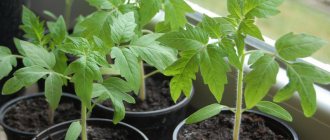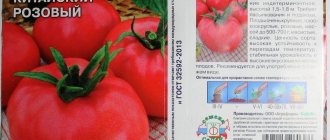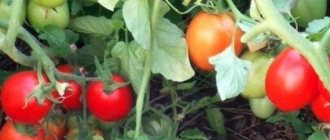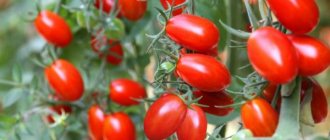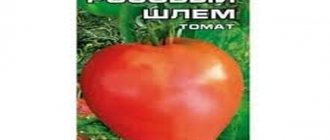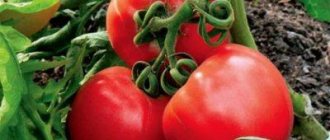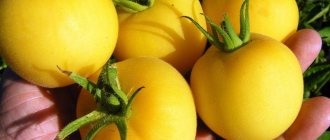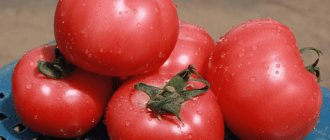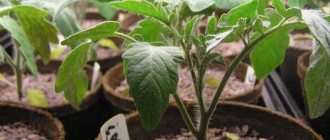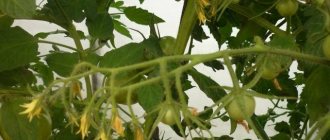Tomato Superpriz F1 is a high-quality early-ripening hybrid created by experienced breeder L. Myazina. It is easy to grow and resistant to poor climatic conditions.
| Height | Landing location | Ripening time | Fruit color | Fruit size | Origin | Fruit shape |
| short | Greenhouse, Open ground | Early ripening | Reds | Average | Hybrid | Flat-round |
a brief description of
- Where to grow: unprotected and closed ground
- Bush height, cm: from 50 to 120
- Growing season, days: 85–95
- Productivity, kg per 1 m2: 8–12 (depending on growing conditions)
- Fruit weight, g: 150–250
- Application: sale, processing, juice production, fresh consumption, preservation
- Advantages:
immunity to late blight, - resistance to cold and frost,
- good presentation,
- productivity.
smaller number and weight of fruits when grown in open ground.
Description
“Super Priz” is a real find for summer residents living in regions with a changeable or harsh climate. The variety responds well to heat and sunlight. But at the same time, it tolerates cold weather well.
The bush belongs to the determinant type. It does not need to be formed into several stems or pinched. Gives away the harvest quickly and amicably. The height of outdoor plants is 50 cm or a little more. There is no need to tie them up or put supports under the branches. Greenhouse plants - up to 120 cm. Long stems are best secured to a trellis.
Early ripening protects against late blight, a fungal disease that affects the above-ground parts of the plant. “Superpriz” is easy to care for and universal in use.
Diseases and pests
The hybrid is very resistant to diseases characteristic of the nightshade family. The plant is not susceptible to diseases such as:
- Apical rot;
- Bacterial leaf spot;
- Root rot;
- VTM.
To prevent late blight, it is recommended to use special chemicals.
Insect pests that can damage the plant:
To control pests, traditional methods should be used, and in cases of severe damage to plantings, insecticides should be used.
Harvest
The weight of greenhouse tomatoes is always slightly larger. They ripen in clusters of 5–6 pieces. At maturity they acquire a bright red color. Covered with smooth, shiny skin. There is no green spot or ribbing near the stalk.
Tomatoes have many good properties:
- wonderful taste and aroma;
- do not crack;
- transfer transportation over long distances;
- are stored for a long time.
They are full of useful substances. They become an ideal base for making juice.
Growing scheme
The recommended method is seedling. Seeds are sown in late March or early April. They and the soil can first be disinfected with a solution of potassium permanganate. Sowing depth is 1.5 cm. Before germination, the container with future tomatoes is placed in a warm place and covered with film.
After the emergence of seedlings, the container with soil is moved to a well-lit place. Water, loosen. They are planted in separate pots made of peat or paper after unrolling a pair of real leaves.
After about 50–60 days, the bushes are ready to be transplanted into the garden plot. Their height should be 15–20 cm. It is desirable that at least 6 leaves and 1 inflorescence form on the stem. The weather should be stable outside. The threat of night frosts has receded.
The seedlings are taken to the dacha in late May or early June. A week before this event, they begin to harden it - take it out into the fresh air for several hours. The recommended layout for the garden bed is 40 x 70 cm. When planting, do not forget about crop rotation. The soil where related crops (potatoes, eggplants, peppers) grew last season can store pathogens. It is better to place the bushes in beds containing cucumbers, onions, carrots, and cabbage.
With proper care and favorable conditions, the plant will begin to bear fruit in early July. The last tomatoes can be removed from the bush at the end of August. Greenhouse tomatoes always produce more yield. The streets aren't growing that much.
Agricultural technology
Even a novice gardener can care for this variety. The absence of the need to form a bush is a clear plus for anyone who has little experience or time. Step-sonning is optional. But it allows you to shorten the growing season.
Care comes down to following simple rules:
- moderate watering early in the morning or after sunset, otherwise the plant will get burned;
- loosening and weeding - prevention of pests and diseases;
- Mulching and ventilating the greenhouse protects against fungus.
Feeding with mineral and organic complexes stimulates growth and the appearance of ovaries.
Photos
Bush care
The plant is unpretentious and does not require close attention. Caring for tomatoes consists of several mandatory activities:
- moderate watering, once every five days is enough;
- periodic loosening to prevent pests and diseases;
- regular weeding;
- feeding with complex fertilizer, depending on soil fertility - at least 4 times.
The “Super Priz F1” variety does not require pinching. Tomatoes are not afraid of temperature changes and are resistant to cold and heat.
The plant is unpretentious and does not require special care. To get a good harvest, you need to follow simple recommendations for growing tomatoes:
- Plants need moderate watering - once every 5-7 days;
- The beds should be regularly weeded to remove weeds;
- Feeding with organic matter and mineral fertilizers is required (about 4 times per season);
- To prevent diseases and pests, you need to regularly loosen the soil under the bushes.
How to fertilize
The first feeding is carried out after picking. After transplantation, fertilizers with nitrogen are added to the soil - industrial preparations or organic matter (mullein, bird droppings). This is recommended to be done only during the period of active formation of green mass. Then the excess content of this element will harm the plant. The trunk and leaves will be thick and strong. And you may not even wait for the flowers and ovaries to appear.
Phosphorus, superphosphate, potassium, and wood ash have a good effect on fruiting. They increase resistance to disease and cold. Root feeding is recommended at the following intervals:
- the first time - 2 or 3 weeks after planting in the garden;
- the second – in a week;
- third – after 14 days;
- fourth (last) – after another 6–10 days.
When fruiting begins, 5 liters of liquid fertilizer can be added to each root. To do this you need to mix water, 1 tsp. nitrophoska, half a teaspoon of sodium humate powder.
Tomato snowfall f1: description and reviews, photos, yield – Fertility
Tomato supernova f1 description, photos, reviews of those who grew it you will find in our article. All about how to grow them and what features this variety has.
Of course, from the name it is clear that this hybrid belongs to the very early varieties in terms of ripening time.
These tomatoes are quite new, they were bred by the famous breeding company Clause, and are rightfully considered one of the most popular varieties of hybrid tomatoes. Let's look at the information on this issue in more detail later in our article.
Tomato supernova f1 reviews, and description of the variety, cultivation:
Growing supernova f1:
In terms of fruit ripening time, find a worthy competitor, since already two months after the seedlings emerge, these tomatoes are ready for consumption. Growing, as a rule, is carried out in greenhouses or hotbeds; the indoor air temperature should be about +23C.
But when the seedlings sprout, the room temperature should be significantly reduced, approximately to the range of +7C to +15C, and it should be cooler at night and warmer during the day. But just don’t lower the temperature overnight, do it gradually over the course of a week.
Also read: Tomato Evpator f1 reviews photo yield
Seedlings are planted in open ground when they reach a size of 30 centimeters and have about nine leaves. Seeds can be planted in open ground only when there is no longer a threat of frost, around mid-April. But, of course, it depends on the specific year and the region in which you live.
Fruit:
Supernova tomato fruit in cross section
The fruits have very high taste qualities, which are far superior to most hybrid varieties. They are very tasty and juicy. Tomatoes are fleshy, have a multi-chambered structure, round in shape, with a spout at the end. The peel is glossy, bright red. Fruit weight is about 250 grams.
Supernova tomatoes have excellent commercial characteristics in terms of appearance, transportability and keeping quality; it would be almost impossible to find a better variety. They are often grown for sale, but this variety is also very popular for home consumption.
The fruits are consumed both fresh and used in preparations for the winter.
Reviews from gardeners about tomato supernova f1
As you can understand from the messages that users post on the Internet, this tomato juice is incredibly popular and enjoys only positive fame. It is resistant to most tomato diseases, the fruits are very tasty, large, pleasant in shape and color. The yield of Supernova tomatoes is quite impressive and amounts to about 100 tons per hectare.
Brief overview of the 'Super Nova' tomato
Result:
Tomato supernova f1, the description that you read, makes it clear that this variety is a must for planting in your greenhouse, because there are practically no negative aspects, but there are a lot of advantages, including high yield, taste, disease resistance, and so on. Those who grew these tomatoes will definitely do it again. For beginners, we recommend that they not be afraid of new things, but be sure to try growing these tomatoes. With this we say goodbye to you, wish you good luck and all the best, until we meet again!
Source:
Tomato Snowfall F1: variety description, reviews, yield, growing features
Home comfort April 1, 2019
Tomato Snowfall F1 is a mid-season hybrid of the first generation. It is easy to grow and produces medium-sized fruits with a moderately sweet taste and rich aroma. The variety is resistant to diseases, and therefore has earned the attention and love of Russian gardeners. Consider the description of the Snowfall tomato.
General characteristics
The originator of the variety is the Pridnestrovian Research Institute of Agriculture. The variety was bred for cultivation both in greenhouses and in open ground. The second option is suitable for regions with warm climates. The hybrid produces a high yield; its bushes reach a height of two meters.
Tomato bushes grow moderately spreading and form a large amount of greenery. The stem is green, thick, the edges are barely noticeable. The leaf is simple, five-lobed, small in size.
The flowers of the plant are small, up to 12 mm in diameter, the inflorescence is a raceme that collects up to 10 flowers. Many ovaries are formed, almost every flower bears fruit.
Fruiting time is 4-5 months from the moment the seeds are planted. The time to obtain tomatoes will depend on when to sow the tomato seedlings during cultivation. To speed up the ripening of fruits, you should increase the amount of heat and light.
Description of fruits
Each cluster forms 8-10 fruits of the same size. The weight of each is 60-80 grams when cultivated in open ground and 80-130 grams in a greenhouse.
The shape of the tomatoes is round, with slight ribbing at the stem. The color of the fruit is uniformly red. The pulp is dense, juicy and meaty.
Gardeners who grow this hybrid note the rich, sweet taste and delicate aroma of tomatoes. They are consumed fresh and canned. The high sugar content allows tomatoes to be used in baby food.
The skin of tomatoes is thin, but durable. For this reason, the fruits tolerate transportation well and are stored for a long time.
Varietal indicators
Speaking about the characteristics of the variety, it is worth noting:
- Tomato yield Snowfall - up to 5 kg per square meter. meter when cultivated in open ground. In a greenhouse, similar numbers can be obtained from each bush.
- The tomato is mid-season in terms of fruiting. In a greenhouse they are 100-110 days. Some sources classify the plant as a late-ripening variety, since when grown in open ground the period increases to 150 days.
- An increase in yield is achieved by sufficient heat and abundant watering. But it should be borne in mind that too frequent watering can lead to cracking of the fruit.
- The tomato is resistant to fungal diseases and tobacco mosaic virus. Occasionally, anthracnose and alternaria may occur.
Advantages and disadvantages
Summarizing the presented indicators, we can highlight the advantages and disadvantages of the variety in question. The advantages include:
- High yield of tomato Snowfall.
- Excellent fruit taste.
- Easy to care for.
- Excellent fruit appearance.
- Resistance to transportation.
- Long shelf life after collection.
- Versatility in use.
- Immunity to diseases.
- Possibility of cultivation in a greenhouse and in open ground.
Among the disadvantages are:
- temperature sensitivity;
- drought intolerance;
- the need for bush formation and tying;
- tendency to form green mass and reduce the size of the fruit.
The characteristics of the Snowfall tomato make it possible to call it one of the most successful varieties for growing in amateur gardens.
Planting seeds
Features of planting the Snowfall tomato are not much different from other varieties. Differences can only be in the timing of crop cultivation.
Gardeners are faced with the question of when to sow tomatoes for seedlings when grown in a greenhouse or in open ground. In the first case, seeds are sown for seedlings at the end of February, in the second - in mid-March.
The soil for seedlings is nutritious, with neutral acidity. You can mix garden soil, humus and sand in equal proportions. A little ash or superphosphate is also added.
Instead of humus, peat is also suitable, then take one part of it, and two parts of earth and sand.
The soil must be disinfected; the seeds are disinfected in a weak solution of potassium permanganate or hydrogen peroxide before planting.
Seeds are sown in plastic containers or individual peat cups. In the latter case, the seedlings will not need to be picked and replanted. Plant the material in small holes 1-2 cm deep, two seeds each.
If containers are used, the distance between the furrows is 5-6 cm. In this case, the seeds are planted one at a time, every 2-3 cm.
Seedlings are fertilized after two leaves appear on the sprouts. A complex fertilizer is suitable for this. If timing allows, the next feeding is carried out 10 days before transplanting to a permanent place.
Planting
When grown in greenhouses, seedlings are transplanted in the second ten days of May; they can be transplanted into open ground in early June. In greenhouses, one or two rows are made with an interval of 70-80 cm between bushes and one meter between rows. In open ground, a planting pattern of 50 x 60 cm is used.
Before planting in a permanent place, seedlings are hardened for 2-3 days. To do this, plants are taken out into the open air (balcony) for several hours a day, gradually increasing this period. In the last two days - for the whole day from morning to evening, they go home at night.
It is better to plant in beds in cloudy weather or in the evening. After transplantation, the soil is compacted and the young tomatoes are watered abundantly.
Features of care
When growing tomatoes, they are watered 2-3 times a week and fed periodically. The first fertilizing is carried out with nitrogen compounds (ammonium nitrate or urea), at the rate of 25 grams per 1 m2.
The second is phosphorus-potassium, it is performed a month after the first. Another month later - the third, also phosphorus-potassium.
You should not overdo it with nitrogen fertilizers, as they lead to an increase in green mass and a decrease in yield.
Foliar feeding is also useful. Snowfall is sprayed with a superphosphate solution 1-2 times during the summer.
It is also worth keeping in mind that too much watering harms plants. The soil should be moistened moderately, increasing the amount of moisture only during dry periods. Water at the root; sprinkling is not recommended. After this, the greenhouse is opened for ventilation. This helps prevent the appearance of blackleg and gray rot.
If aphids are noticed on the bushes, they are washed with soapy water. A solution of ammonia helps against slugs. To do this, 1 liter of ammonia with a concentration of 10% is diluted in 5 liters of water. If there is no ammonia in such quantities, you can take less. The prepared solution is sprayed on the plants.
What to pay attention to when growing?
When cultivating the Snowfall tomato, you should pay close attention to the formation of bushes. This process begins immediately after transplantation and continues until fruiting. Bushes should have one or two stems. At the same time, it is important to constantly remove stepchildren. The bushes grow quite tall, so they are tied to trellises.
The use of mulch will greatly facilitate many stages of tomato cultivation, and this is also worth considering in advance. Sawdust or peat are suitable for tomatoes. Such mulch will prevent the proliferation of pests and simplify the process of caring for plants, eliminating constant loosening and removal of weeds.
If a problem such as fungal infection of tomatoes occurs, copper sulfate or Bordeaux mixture will help. The parts of the plant affected by the disease are completely removed. To control pests, use insecticides or a decoction of onion peels and celandine. Such compositions can be used for spraying and also for watering beds where bushes grow.
Who does he get along with?
Snowfall is a mid-season variety, so tomatoes with other growing seasons can be planted in the same greenhouse with it. For example, ultra-early varieties: Irishka, Ivanhoe, Indigo. Their fruits will appear earlier, but they differ in no less rich taste.
Among the late-ripening varieties you can consider Chernomor, Black Baron, and Bull's Heart.
